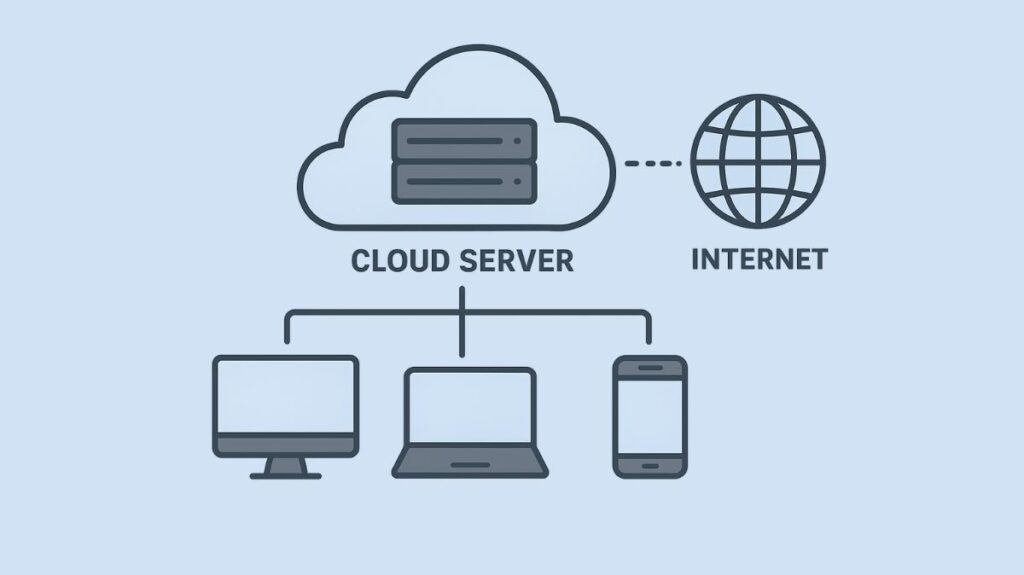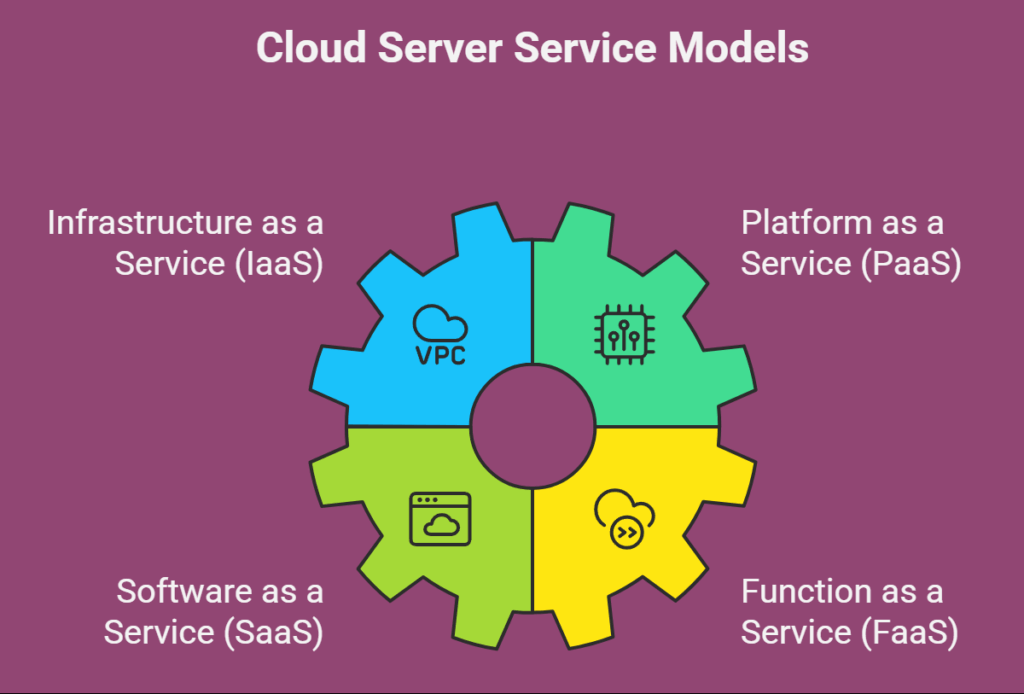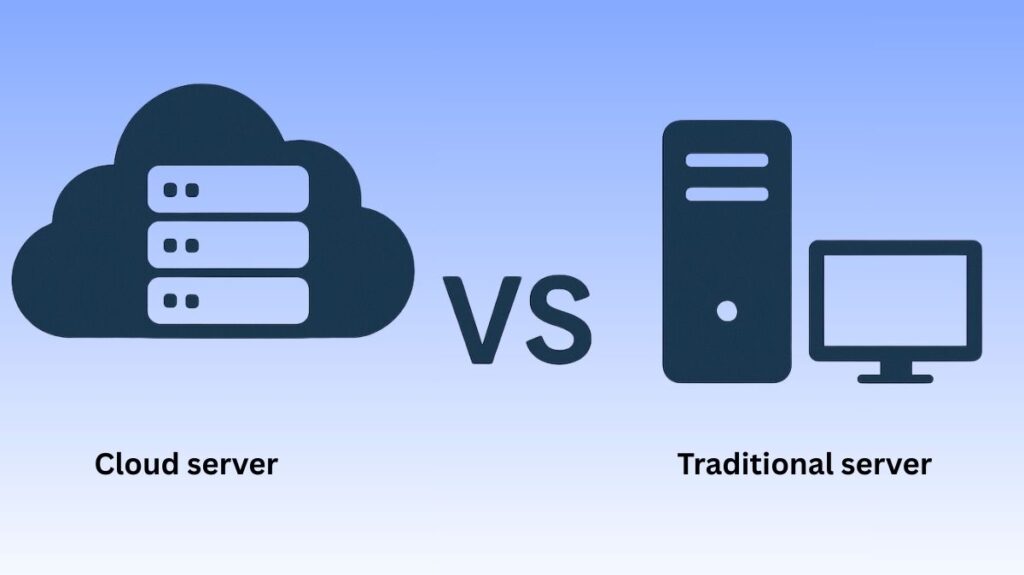This blog covers a wide range of topics, including cloud servers, how it works, their features, advantages, challenges and considerations, cloud server service models, types of cloud deployments, cloud server software, how to choose a cloud server, cloud server providers, and cloud server vs traditional server.
Cloud servers

Virtual servers that operate in cloud computing environments, as opposed to being housed on actual hardware at a business’s location are known as cloud servers. Through the internet, it makes computing resources like storage, processing power, networking, and software available whenever needed.
In summary, a cloud server allows you to access computer power via the internet without having to worry about managing or owning the actual hardware.
How Cloud Servers Work
One of the key technologies in cloud computing, virtualization, enables cloud servers.
- A single, potent physical server (referred to as a host) is divided into numerous separate virtual server instances (VMs) by virtualization software (hypervisor).
- The physical hardware resources, including network interface cards (NICs), RAM, storage, and virtual CPUs (vCPUs), are managed and distributed to each virtual machine (VM) by the hypervisor. After then, each virtual machine functions as though it were running on a separate real server.
- Cloud service providers view their resources as a sizable pool that is distributed to users on a dynamic basis. This method makes it possible to allocate resources in a flexible and effective way.
- Cloud-based Application Programming Interfaces (APIs) are used to provision and administer cloud servers remotely. During this process, desirable server characteristics such as CPU, memory, storage, and operating system are specified.
- Through remote terminal connections using protocols like SSH (Secure Shell), which normally operates on port 22, users can access these virtual servers over the internet. For instance, web servers employ HTTP (port 80) and HTTPS (port 443) to connect with users.
Features of Cloud Servers
A number of features set cloud servers apart from conventional servers, including:
- Virtualization: The same physical hardware can host several virtual servers.
- On-demand self-service: Usually using a web application, users can order, change, and cancel services without interacting with a human.
- Wide network access: Any network, including the Internet, can provide services from a variety of devices.
- Resource pooling: Users typically don’t need to know the precise location because provider resources (CPU, RAM, storage, and network) are dynamically distributed among a sizable pool.
- Rapid elasticity: The pool of resources seems limitless and may swiftly grow or shrink to satisfy demand.
- Measured service: For invoicing and transparency purposes, usage can be tracked and reported.
- Scalability: Depending on demand, resources (CPU, RAM, and storage) can be readily scaled up or down.
- Flexibility: Adaptable to different workloads and available online from any location.
- Cost-Effectiveness: Pay-as-you-go (PAYG) models are frequently used, which lowers initial hardware expenditures and continuing maintenance.
- High Availability: Uptime and catastrophe recovery are guaranteed by integrated redundancy and failover techniques.
- Managed Services: The cloud provider frequently takes care of security, maintenance, and upgrades.
Also Read About What is Cloud Management? and Cloud Computing management
Advantages of cloud servers
Cloud servers are chosen by organizations for a variety of reasons:
Affordability
Lowers continuing maintenance expenses and does away with the requirement for a sizable upfront capital investment in hardware. Users just have to pay for the resources they use.
Convenience and Usability
IT teams can free up time by managing resources via control panels or APIs and provisioning them in a matter of minutes. Installation, upkeep, and updates of servers are managed by cloud providers.
Scalability
Quickly adapt storage and processing power to changing needs.
Reliability
Even in the event of component failure, continuous service is guaranteed by integrated redundancy and sophisticated load balancing.
Flexibility
Facilitates remote access from any location, enabling a workforce that is adaptable to a range of workloads.
Disaster Recovery
Fast data restoration is ensured by automated backups, data replication, and failover features.
Globalization
By placing redundant instances in various parts of the world, users who are geographically separated can have lower latency and better performance.
Improved Collaboration
Better cooperation is made possible by centralized data access and storage.
Processing Power
Provide strong processing power for workloads including AI and ML as well as other demanding computational activities.
Challenges and Considerations of Cloud Servers
Cloud servers have advantages, but they can have drawbacks.
- Less Control: Businesses that use public clouds are less in charge of their infrastructure directly.
- Performance Problems (“Noisy Neighbour”): In multi-tenant settings, a virtual machine’s performance may be negatively impacted by the needs of other cloud servers running on the same physical hardware. This can be lessened by using bare-metal or dedicated cloud servers.
- Outages and Resilience: Because of network interruptions or provider errors, cloud servers may experience erratic service outages. The user must intentionally design high availability into the cloud system.
- Security Issues: Using third-party services to handle sensitive data poses issues with cyber threats, unauthorised access, and data breaches. Users need to be proactive as well.
- Bandwidth Sharing: When several users share physical resources in multi-tenant setups, competition for bandwidth may arise.
- Governance and Regulation: Data storage in specific geographic areas may be restricted by regulatory requirements.
- Cost management: Although public cloud servers are frequently less expensive than physical servers, they can become more costly over time or when used full-time, and there may be additional expenses.
- Insufficient Knowledge: Insufficient knowledge of cloud technologies can impede efficient administration and optimization.
- Customizations: With higher processing power, RAM, and backup power, physical servers are usually more adaptable.
Cloud Server Service Models

Different “as a Service” models with varying degrees of client management responsibilities are available for cloud servers:
Infrastructure as a Service (IaaS): The simplest straightforward type is Infrastructure as a Service (IaaS), in which the cloud provider grants access to virtualized computer resources (VMs, networks, and storage). Installing and maintaining their own operating systems and apps is the customer’s responsibility. AWS EC2, Microsoft Azure Virtual Machines, and Google Cloud Platform Compute Engine are a few examples.
Platform as a Service (PaaS): Usually on virtual machines (VMs), the provider provides a development platform that includes the operating system and pre-configured software development tools. Without overseeing the supporting infrastructure, developers concentrate on writing code.
Software as a Service (SaaS): The provider oversees all aspects of the application, including the software, operating system, and virtual machines. The underlying virtual machines are concealed when the user accesses the application through the Internet. Dropbox, Google Drive, Exchange Online, and Microsoft Office 365 are a few examples.
Function as a Service (FaaS): Also known as “serverless functions,” FaaS lets developers run code in response to events without managing servers.
Types of Cloud Deployments
There are various cloud models in which cloud servers can be deployed:
- Public Clouds: Hosted by outside providers and shared by several users, these services and apps are made publicly accessible over the Internet.
- Private Clouds: These services and apps are designed for a particular company, frequently utilising its own private network infrastructure. They provide greater control and improved security and can be managed by a third party or hosted on-site.
- Hybrid Clouds: A mix of two or more different clouds (private and public, for example) that are linked by a common architecture. This offers a harmony between authority and adaptability.
- Community Clouds: Designed specifically for a particular community with unique functional requirements.
Cloud Server Software
An operating system is required to set up a cloud server; Linux-based solutions, such as Ubuntu or Rocky Linux, are popular because of their extensive support and adaptable license. Usually configured through a command-line interface, server-side software operates in a cloud environment and is accessed by users via a web browser or other apps. Important elements consist of:
- Web servers, such as Nginx and Apache HTTP Web Server, facilitate communication with users by retrieving and transmitting HTML content.
- API servers: Software middlemen that facilitate communication between apps (e.g., retrieving weather data). One kind of API server is a web server.
- Database servers: Some may have web interfaces, while others are internally accessible and can be accessed through a database query API. MongoDB, Kafka, MySQL, PostgreSQL, Valkey, and OpenSearch are a few examples.
Cloud server types (by hosting and configuration)
The configuration of cloud servers and how they relate to the underlying physical server architecture can also be used to classify them.
By Configuration
- General purpose: Web servers and small-to-medium databases can benefit from balanced CPU, memory, and storage.
- Compute-optimized: Perfect for CPU-intensive tasks like batch processing, this system has a high CPU core to memory ratio.
- Memory-optimized: Applications that require huge datasets in memory (such as in-memory databases) have a high RAM to CPU core ratio.
- Accelerated computing: Outfitted with GPUs and FPGAs for specialist activities like scientific simulation, machine learning, and graphics rendering.
- Storage-optimized: High disc throughput for workloads (such big data analytics) that need fast access to massive amounts of data.
- High-performance computing (HPC): Specifically designed for workloads requiring high network performance and low latency due to computational demands.
By Type of Hosting
- Shared hosting: A single physical server’s resources are shared by several cloud servers. One person’s heavy workload may affect others. They are also known as public cloud servers.
- Virtual Private Server (VPS) hosting: A cloud server that operates on a shared physical server but has been allotted a specific amount of resources to avoid being impacted by the heavy workloads of other servers. One cloud VPS example is Droplets from DigitalOcean.
- Dedicated hosting: A whole physical server that is given to one company with total control. It can be set up as one cloud server or as several servers. Also referred to as bare-metal servers or private cloud servers, these servers provide hardware isolation.
Cloud Server vs Traditional Server

Compared to conventional, on-premises physical servers, cloud servers have the following benefits:
- Location and Management: A third-party provider remotely hosts cloud servers, which are accessible over a network. Server management falls to the supplier. Conventional servers are located on-site and are run by internal IT personnel.
- Scalability: Unlike traditional servers, which necessitate the purchase of physical equipment, cloud servers dynamically modify their resources.
- Workloads: Traditional servers are better for steady, high-demand workloads, while cloud servers are best for varying workloads.
- Cost Structure: In order to minimise significant upfront capital expenditures and continuous maintenance expenses, cloud servers generally employ a PAYG model.
- Capacity: Unlike physical servers constrained by current infrastructure, cloud servers provide nearly infinite compute capacity.
- Customization: Physical servers, which provide more memory and computing capability, are frequently more configurable.
Also Read About Multicloud Architecture, Its Advantages, Use case & Elements
| Feature | Cloud Server | Traditional Server (On-Premises) |
| Control | Provider manages the underlying hardware; users control the virtual server. | Organization has full control over the hardware, software, and security. |
| Cost | Typically a pay-as-you-go operational expense (OPEX). No upfront capital investment in hardware. | Requires significant upfront capital expenditure (CAPEX) for hardware and ongoing maintenance costs. |
| Scalability | Highly scalable. You can quickly add or remove resources (e.g., CPU, RAM, storage) on demand. | Scaling is a time-consuming and costly process, often requiring new hardware purchases and installations. |
| Maintenance | The cloud provider handles all hardware maintenance, security, and updates. | Your internal IT team is responsible for all maintenance, repairs, and updates. |
| Accessibility | Accessible remotely from anywhere with an internet connection. | Typically accessed only from within the physical location or via a secure VPN. |
| Reliability | High availability and redundancy are built-in, as data is distributed across multiple servers. If one fails, another takes over. | Reliability is dependent on your own hardware and backup systems. A single point of failure can cause significant downtime. |
Choosing a Cloud Server
The choice is based on the particular requirements, assets, and expansion strategies of a business. Important things to think about are:
- Business Requirements: The type of applications, storage requirements, anticipated traffic, and whether workloads are data-sensitive or flexible are examples of business requirements.
- Security Record: Examine the provider’s compliance, data encryption, access controls, and security measures.
- Scalability: Verify that the supplier can handle expansion without experiencing prolonged outages or incurring extra expenses.
- Performance and Reliability: Assess latency levels and uptime assurances.
- Pricing Models: Comprehend the cost structure and make sure it fits the budget, whether it is fixed pricing or PAYG.
- Customer service: Evaluate your options for live chat, round-the-clock assistance, and committed managers.
- Data Centre Locations: Take performance and adherence to regional data protection regulations into account.
- Virtualization Technology: Look at the type, configuration, and virtualisation technology of the cloud servers that the provider utilizes.
Also Read About What Is The Differences Between Cloud And Servers
Cloud Server Providers and Offerings Examples
Among the notable examples are:
Amazon Web Services (AWS)
Provides preconfigured virtual private servers using Amazon Lightsail and Elastic Compute Cloud (EC2) instances. AWS Amplify is used to create and host static websites or single-page web apps with a serverless backend.
Azure
Offers Windows Server, SQL Server on Azure Virtual Machines, Linux virtual machines, Azure Functions, and Azure Virtual Machine Scale Sets.
Google Cloud Platform
Provides instances of Compute Engine.
IBM Cloud
Provides cloud servers, including bare-metal solutions, while taking provider reliability, pricing, and technology into account. With Linux and open-source workloads, IBM LinuxONE prioritises enterprise security and performance.
DigitalOcean
In addition to Kubernetes, managed databases, and object storage, DigitalOcean offers “Droplets” as scalable virtual machines.
IONOS
Offers dedicated servers, cloud servers, and VPS hosting.
Cisco’s Virtual Offerings
- Cisco’s server hardware product range is called Unified Computing System (UCS).
- A virtual router that operates as a virtual machine (VM) in a cloud service, the Cisco Cloud Services Router (CSR) gives users control over routing features, including shutting down VPNs, inside the cloud environment.
- Access points (APs) can be automatically deployed and controlled from a cloud web interface with Cisco Meraki’s cloud-based AP management service. Likewise, in a private cloud data centre, a cloud-based Wireless LAN Controller (WLC) deployment installs the WLC as a virtual machine (VM).
